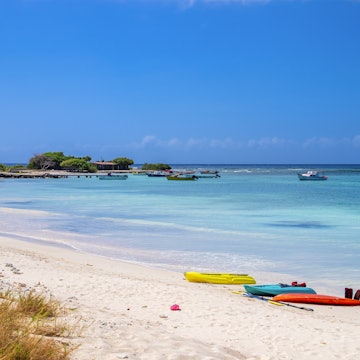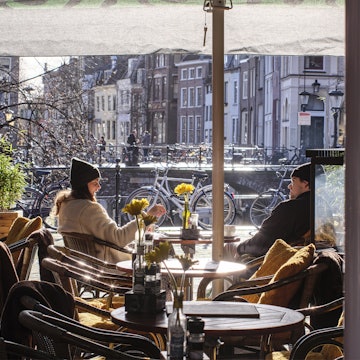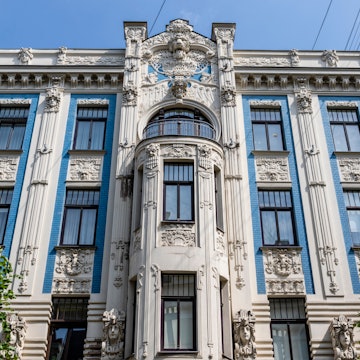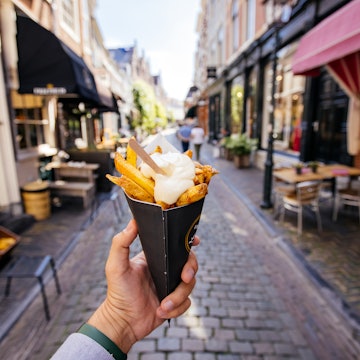

Everywhere in the Netherlands is easily accessible, like Rotterdam with its mix of architecture © Victor Maschek / Shutterstock
With its beautiful cities and countryside of polders, dykes, windmills and canals connected by superb, sustainable infrastructure, the Netherlands is one of the easiest places to travel. As a visitor, you won’t find too many potential pitfalls, but there are still a few things to be aware of (starting with getting its name right!). Having written about this charming and fascinating country for almost two decades (and experienced it over a lifetime), these are my key tips for a smooth trip.
1. It’s the Netherlands (not Holland)
You’ll come across plenty of references to “Holland” as a synonym for the entire country (it’s only recently started transitioning out of use by the Dutch tourism authority) but in fact Holland refers to just two of the country’s 12 provinces: Noord-Holland (North Holland; Haarlem is the provincial capital, while Amsterdam is the largest city and national capital) and Zuid-Holland (South Holland; Den Haag is the provincial capital and seat of government and royalty, with Rotterdam the largest city). The rest of the country is not Holland, and the nation as a whole is the Netherlands.
You might also hear references to the Randstad, the conurbation that takes in the Netherlands’ biggest cities in Noord-Holland, Zuid-Holland and Utrecht, which forms the country’s economic engine and is home to almost half of its population.

2. Remember there’s more to Amsterdam than the city center – and more to the Netherlands than Amsterdam
Amsterdam is where most people arrive, and for many it’s their only destination. With visitor numbers skyrocketing, the Dutch capital is balancing overtourism through measures such as raising tourist taxes; restricting short-stay apartment rental and house swaps; capping the number of annual overnight visitors; halving river cruises; and closing its ocean-liner cruise ship port completely. It is also deterring raucous, hard-partying “nuisance tourists” (by banning organized pub crawls and curbing central bar and club opening hours) while still welcoming respectful visitors.
You don’t have to go far from the center to discover fantastic, often under-the-radar neighborhoods, such as Amsterdam’s West, Oost (East) and Noord (North), where you’ll get a deeper insight into local life. Positive-impact tours run by Tours That Matter are also a great way to get off the tourist track.
Added to that, the Netherlands’ compact size and excellent transport puts the country’s grand cities, classic landscapes and exhilarating things to do (and invariably cheaper prices) right on Amsterdam’s doorstep.
3. Decide how long to spend in the Netherlands
Crossing the country takes just a few hours but there’s a lot to see. A week will give you time to experience Amsterdam and surrounding destinations (such as Haarlem, Utrecht, Leiden, Delft, Den Haag and Rotterdam). The longer you have, the more you can explore all corners of the country, from the Frisian coast and islands to superbly preserved Hanseatic cities such as Deventer and Zwolle, and the hilly southeast around vibrant Maastricht.
When you’re putting together your itinerary, you can get a good sense of travel times on journey planner 9292.nl, which calculates the most efficient public transport routes throughout the country. Traveling by bike, using the country’s extensive system of short- and long-distance cycleways, is also entirely viable and an enjoyable way to get around. Cycling is part of the Dutch DNA (locals ride literally everywhere: work, dinner, the opera, you name it), so you’ll be in good company.
Discover the best ways to get around the Netherlands

4. Book museum time-slots in advance to avoid missing out
As the home turf of artistic masters from Rembrandt and Vermeer to Van Gogh, Mondrian and MC Escher, the Netherlands brims with incredible art, and hundreds of museums also showcase the country’s rich history, traditions and diversity. Increasingly, museum entry requires you to reserve a time slot online. These can quickly fill up in advance, so book them a few weeks ahead (even earlier for the Anne Frank Huis), so you have a framework for the rest of your schedule.
5. Lock in accommodation and popular restaurant bookings ahead of time, too
Especially if you’re traveling in the high summer season or during festivals, events and holidays, you should make sure you have your accommodation booked ahead. High-end and/or popular restaurants should also be reserved well in advance.

6. Pack practically and plan for fickle weather
There’s a reason windmills are a fixture across the flat landscape: it can get distinctly breezy here (the uniquely Dutch verb uitwaaien means “to clear one's head by taking a walk outdoors in the windy fresh air”), and the maritime climate also means plenty of rain, so pack waterproofs, no matter the season. You’ll also be glad of comfortable, sturdy footwear for walking on all terrains, a slimline daypack and layers you can quickly put on if things turn chilly. Warm clothes, gloves and a woolen hat are essential in winter.
The Dutch cycling culture means fashion is not only stylish (Dutch design is big here) but practical (such as flat soles and clothing that won’t get caught in bicycle spokes).
Consider traveling to the Netherlands outside the summer peak: here’s the best time to go
7. Anticipate what to expect at your accommodation
Accommodation in the Netherlands can spring a few surprises on the uninitiated. In older buildings especially, there might not be air conditioning and elevators might be tiny or non-existent (and Dutch staircases can be precipitously steep, often more akin to ships’ ladders). Attitudes tend to be quite liberal and straightforward, and bathrooms can be more open-plan than you might expect and/or have limited screening (yes, often even the toilets). If modesty is important to you, this is something you’ll want to look into when booking; once you check in, alternative rooms might not be available.
To let natural light in, hotels and residential homes and apartments often have large windows without blinds or drapes, but in a small, densely populated country, people respect each other’s privacy.

8. Get to grips with Dutch communication
The Dutch are clear, concise communicators, favoring directness over small talk. To visitors, this might come across as bracingly frank but it’s simply intended to be pragmatic, open and honest. Punctuality is expected in formal and social situations.
Excellent, fluent English is widely spoken, but a few words of Dutch can help grease the wheels of communication, such as goedemorgen/goedendag/goedenavond (good morning/day/evening), tot ziens (goodbye), alstublieft/alsjeblieft (formal/informal for please), and dank u wel/dank je wel (formal/informal for thank you). Toast a frothy beer or jenever (aka genever; Dutch gin) with proost (cheers) while making eye contact with everyone you’re toasting. Dutch drinking culture is social, revolving around food and friends, starting with borrel (“drinks”) before uitgaan (going out).
9. Embrace sustainability
In a country lying mostly below sea level, environmental concerns have long been top of mind, and the Dutch are blazing the way on sustainability. The Netherlands is aiming for a circular economy by 2050, reusing, repairing and recycling renewable materials to eliminate waste, and rapid progress is being achieved across day-to-day life. Everything you can do as a visitor (using eco-friendly transport, minimizing energy consumption, packaging and food waste, dining on local and organic produce and shopping sustainably) will help.
10. Understand tipping etiquette
In the Netherlands, remuneration in hospitality professions includes service, so staff here aren’t working for tips. That being said, many people do tip moderately (up to around 10%) for excellent service, especially in restaurants and bars where drinks are brought to the table.
11. Carry both cards and cash
Contactless cards and app-based ”smart wallet” digital payments are becoming increasingly common (such as the public transport system), and many businesses such as cafes, restaurants and shops (even some supermarkets) in larger cities especially are entirely cashless. On the flipside, many traditional establishments don’t take cards and only accept cash. It’s handy to have a mix of cash and cards to cover your bases.

12. Beware of bike lanes
Bike-lane traffic can move much faster, and in much higher volumes, than you might expect. Along with speedy cyclists, beware of motorized electric bikes and larger cargo bikes. As a pedestrian, be vigilant when crossing the road. Wandering into a bike lane without looking in both directions can cause serious accidents. Drivers should be extra mindful.
If you’re joining the locals and cycling yourself, watch out for other cyclists and oblivious pedestrians as well as vehicles, and ring your bicycle bell as a warning as often as necessary. Cross tram tracks at a sharp angle to avoid your wheels getting stuck. Before heading out, familiarize yourself with the rules of participating in Dutch traffic.
Save this guide to the best cycling routes in the Netherlands
13. Take care on and around canals
The Netherlands’ picturesque waterways in its cities, towns and countryside are rarely if ever fenced or protected by barriers. Keep an eye out, especially if you’re traveling with young children. If you’re renting a boat to explore (one of the best things you can do in the Netherlands), ensure life jackets are provided for all passengers, including for kids.
14. Drink the tap water freely
Tap water is high quality and safe to drink throughout the Netherlands (any exceptions will be clearly indicated).
15. Don’t be alarmed by the signal testing of sirens (but do take them seriously in an emergency)
If you’re here at noon on the first Monday of the month (public holidays excepted), you’ll hear the Netherlands’ public warning sirens sound for an uninterrupted one minute and 26 seconds, when they’re simultaneously tested across the country. If you hear them at any other time, you should assume it’s an emergency (such as a fire or flood) and follow local instructions.
16. Stay safe and know how to find help if you need it
The Netherlands is an extremely safe country, but you should take the usual precautions in big cities, and watch out for pickpockets in areas where tourists congregate (such as main railway stations). Protect against bicycle theft by parking in secure bike-parking stations where possible, and always use two locks (one should be attached to a fixed structure like a bike rack).
For a minor illness or injury, an apotheek (pharmacy) can provide advice and sell over-the-counter medication, and advise where to get more specialized help.
It’s important to be aware that cannabis is illegal in the Netherlands, and while small quantities (up to 5g) are generally tolerated by authorities, it’s policed differently by municipalities across the country, and some areas enforce cannabis-smoking bans in public places. (Government policies are also apt to change.) Never buy any drugs on the streets – fatalities can and do occur.
In a serious emergency, contact the police, fire and ambulance services by dialing 112. If things do go wrong during your trip, it will help to have easily accessed back-up copies of your travel insurance policy.
















